DNA Methylation Negatively Regulates Gene Expression of Key Cytokines Secreted by BMMCs Recognizing FMDV-VLPs
Abstract
1. Introduction
2. Results
2.1. Generation and Characterization of Virus-like Particles
2.2. Determination of 5-Azacytidine (5-AZA) Dose on BMMCs
2.3. DNA Methylation Inhibited the Transcription of Key Cytokines in BMMC Recognition of FMDV-VLPs
2.4. DNA Methylation Inhibited the Expression of Key Cytokines in BMMC Recognition of FMDV-VLPs
2.5. DNA Methylation Mainly Downregulates NF-κB Expression in BMMC Recognition of FMDV-VLPs
2.6. Analysis of DNA Methylation Levels and Patterns
3. Discussion
4. Materials and Methods
4.1. Plasmids, Cells, and Mice
4.2. Preparation of FMDV-VLPs
4.3. Preparation and Identification of BMMCs
4.4. Determination of 5-Azacytidine (5-AZA) Dose
4.5. Real-Time Quantitative PCR
4.6. Enzyme-Linked Immunosorbent Assay (ELISA)
4.7. Western Blot
4.8. Measurement of DNA Methylation Levels in Promoter DNA
4.9. Statistical Analysis
5. Conclusions
Supplementary Materials
Author Contributions
Funding
Institutional Review Board Statement
Informed Consent Statement
Data Availability Statement
Acknowledgments
Conflicts of Interest
References
- de Los Santos, T.; Diaz-San Segundo, F.; Rodriguez, L.L. The Need for Improved Vaccines against Foot-and-Mouth Disease. Curr. Opin. Virol. 2018, 29, 16–25. [Google Scholar] [CrossRef]
- Diaz-San Segundo, F.; Medina, G.N.; Stenfeldt, C.; Arzt, J.; de los Santos, T. Foot-and-mouth Disease Vaccines. Vet. Microbiol. 2017, 206, 102–112. [Google Scholar] [CrossRef] [PubMed]
- Singanallur, N.B.; Dekker, A.; Eblé, P.L.; van Hemert-Kluitenberg, F.; Weerdmeester, K.; Horsington, J.J.; Vosloo, W. Emergency FMD Serotype O Vaccines Protect Cattle against Heterologous Challenge with a Variant Foot-and-mouth Disease Virus from the O/ME-SA/Ind2001 Lineage. Vaccines 2021, 9, 1110. [Google Scholar] [CrossRef] [PubMed]
- Liu, J.H.; Zhang, J.J.; Han, W.J.; Cui, C.; Li, M.Z.; Tian, Z.Y.; Bai, R.M.; Li, L.M. B Cell Memory Responses Induced by Foot-and-mouth Disease Virus-like Particles in BALB/c Mice. Vet. Immunol. Immunopathol. 2022, 250, 110458. [Google Scholar] [CrossRef] [PubMed]
- Teng, Z.; Sun, S.; Luo, X.; Zhang, Z.; Seo, H.; Xu, X.; Huang, J.; Dong, H.; Mu, S.; Du, P.; et al. Bi-functional Gold Nanocages Enhance Specific Immunological Responses of Foot-and-mouth Disease Virus-like Particles Vaccine as a Carrier and Adjuvant. Nanomedicine 2021, 33, 102358. [Google Scholar] [CrossRef] [PubMed]
- Mignaqui, A.C.; Ferella, A.; Cass, B.; Mukankurayija, L.; L’Abbé, D.; Bisson, L.; Sánchez, C.; Scian, R.; Cardillo, S.B.; Durocher, Y.; et al. Foot-and-Mouth Disease: Optimization, Reproducibility, and Scalability of High-yield Production of Virus-like Particles for a next-generation Vaccine. Front. Vet. Sci. 2020, 7, 601. [Google Scholar] [CrossRef]
- Han, W.J.; Zhang, J.J.; Zhang, Y.M.; Wang, J.X.; Li, L.M. Cytokine Responses of Bone Marrow-derived Mast Cells to FMDV-VLPs via Mannose Receptor. Acta Vet. Zootech. Sin. 2022, 53, 3917–3926. (In Chinese) [Google Scholar] [CrossRef]
- Jaenisch, R.; Bird, A. Epigenetic Regulation of Gene Expression: How the Genome Integrates Intrinsic and Environmental Signals. Nat. Genet. 2003, 33, 245–254. [Google Scholar] [CrossRef]
- Schübeler, D. Function and Information Content of DNA Methylation. Nature 2015, 517, 321–326. [Google Scholar] [CrossRef]
- Paivandy, A.; Grujic, M.; Rafati, N.; Pejler, G. DNA Demethylation Regulates Gene Expression in IgE-activated Mouse Mast Cells. Allergy 2020, 75, 1776–1780. [Google Scholar] [CrossRef]
- Ghazimoradi, M.H.; Farivar, S. The Role of DNA Demethylation in Induction of Stem Cells. Prog. Biophys. Mol. Biol. 2020, 153, 17–22. [Google Scholar] [CrossRef]
- Brandt, B.; Rashidiani, S.; Bán, Á.; Rauch, T.A. DNA Methylation-governed Gene Expression in Autoimmune Arthritis. Int. J. Mol. Sci. 2019, 20, 5646. [Google Scholar] [CrossRef] [PubMed]
- McGrath-Morrow, S.A.; Ndeh, R.; Helmin, K.A.; Chen, S.Y.; Anekalla, K.R.; Abdala-Valencia, H.; D’Alessio, F.R.; Collaco, J.M.; Singer, B.D. DNA Methylation Regulates the Neonatal CD4+ T-cell Response to Pneumonia in Mice. J. Biol. Chem. 2018, 293, 11772–11783. [Google Scholar] [CrossRef] [PubMed]
- Luo, C.; Hajkova, P.; Ecker, J.R. Dynamic DNA Methylation: In the Right Place at the Right Time. Science 2018, 361, 1336–1340. [Google Scholar] [CrossRef] [PubMed]
- Moore, L.D.; Le, T.; Fan, G. DNA Methylation and Its Basic Function. Neuropsychopharmacology 2013, 38, 23–38. [Google Scholar] [CrossRef] [PubMed]
- Osorio-Montalvo, P.; Sáenz-Carbonell, L.; De-la-Peña, C. 5-Azacytidine: A Promoter of Epigenetic Changes in the Quest to ImProve Plant Somatic Embryogenesis. Int. J. Mol. Sci. 2018, 19, 3182. [Google Scholar] [CrossRef]
- Shen, J.; Liu, Y.; Ren, X.; Gao, K.; Li, Y.; Li, S.; Yao, J.; Yang, X. Changes in DNA methylation and Chromatin Structure of Pro-Inflammatory Cytokines Stimulated by LPS in Broiler Peripheral Blood Mononuclear Cells. Poult. Sci. 2016, 95, 1636–1645. [Google Scholar] [CrossRef]
- Jiménez, M.; Cervantes-García, D.; Córdova-Dávalos, L.E.; Pérez-Rodríguez, M.J.; Gonzalez Espinosa, C.; Salinas, E. Responses of Mast Cells to Pathogens: Beneficial and Detrimental Roles. Front. Immunol. 2021, 12, 685865. [Google Scholar] [CrossRef]
- Elieh Ali Komi, D.; Wöhrl, S.; Bielory, L. Mast Cell Biology at Molecular Level: A Comprehensive Review. Clin. Rev. Allergy Immunol. 2020, 58, 342–365. [Google Scholar] [CrossRef]
- Katsoulis-Dimitriou, K.; Kotrba, J.; Voss, M.; Dudeck, J.; Dudeck, A. Mast Cell Functions Linking Innate Sensing to Adaptive Immunity. Cells 2020, 9, 2538. [Google Scholar] [CrossRef]
- Suto, H.; Nakae, S.; Kakurai, M.; Sedgwick, J.D.; Tsai, M.; Galli, S.J. Mast Cell Associated TNF Promotes Dendritic Cell Migration. J. Immunol. 2006, 176, 4102–4112. [Google Scholar] [CrossRef] [PubMed]
- Dudeck, J.; Ghouse, S.M.; Lehmann, C.H.K.; Hoppe, A.; Schubert, N.; Nedospasov, S.A.; Dudziak, D.; Dudeck, A. Mast-cell-derived TNF Amplifies CD81 Dendritic Cell Functionality and CD81 T Cell Priming. Cell Rep. 2015, 13, 399–411. [Google Scholar] [CrossRef] [PubMed]
- McGowen, A.L.; Hale, L.P.; Shelburne, C.P.; Abraham, S.N.; Staats, H.F. The Mast Cell Activator Compound 48/80 is Safe and Effective when Used as an Adjuvant for Intradermal Immunization with Bacillus Anthracis Protective Antigen. Vaccine 2009, 27, 3544–3552. [Google Scholar] [CrossRef]
- Díaz-San Segundo, F.; Rodríguez-Calvo, T.; de Avila, A.; Sevilla, N. Immunosuppression During Acute Infection with Foot-and-mouth Disease Virus in Swine is Mediated by IL-10. PLoS ONE 2009, 4, e5659. [Google Scholar] [CrossRef] [PubMed]
- Zhang, Z.; Doel, C.; Bashiruddin, J.B. Interleukin-10 Production at the Early Stage of Infection with Foot-and-mouth Disease Virus Related to the Likelihood of Persistent Infection in Cattle. Vet. Res. 2015, 46, 132. [Google Scholar] [CrossRef][Green Version]
- Soria-Castro, R.; Alfaro-Doblado, Á.R.; Rodríguez-López, G.; Campillo-Navarro, M.; Meneses-Preza, Y.G.; Galán-Salinas, A.; Alvarez-Jimenez, V.; Yam-Puc, J.C.; Munguía-Fuentes, R.; Domínguez-Flores, A.; et al. TLR2 Regulates Mast Cell IL-6 and IL-13 Production during Listeria Monocytogenes Infection. Front. Immunol. 2021, 12, 650779. [Google Scholar] [CrossRef]
- Liu, J.H.; Cui, C.; Zhang, J.J.; Han, W.J.; Zhang, Y.M.; Li, L.M.; Wang, J.X. Effect of Mast Cells Activation Induced by Foot-and-mouth Disease Virus-like Particles on IgG Immune Responses in Mice. Chin. J. Vet. Sci. 2021, 10, 1983–1989. (In Chinese) [Google Scholar] [CrossRef]
- Zhang, J.J.; Han, W.J.; Li, M.Z.; Bai, R.M.; Tian, Z.Y.; Yuan, W.Z.; Li, L.M. Histone Acetylation Regulates BMMCs Recognition of Foot-and-mouth Disease Virus-like Particles. Int. Immunopharmacol. 2023, 121, 110428. [Google Scholar] [CrossRef]
- Mittelstaedt, N.N.; Becker, A.L.; de Freitas, D.N.; Zanin, R.F.; Stein, R.T.; Duarte de Souza, A.P. DNA Methylation and Immune Memory Response. Cells 2021, 10, 2943. [Google Scholar] [CrossRef]
- Yin, Y.; Morgunova, E.; Jolma, A.; Kaasinen, E.; Sahu, B.; Khund-Sayeed, S.; Das, P.K.; Kivioja, T.; Dave, K.; Zhong, F.; et al. Impact of Cytosine Methylation on DNA Binding Specificities of Human Transcription Factors. Science 2017, 35, eaaj2239. [Google Scholar] [CrossRef]
- Eden, S.; Hashimshony, T.; Keshet, I.; Cedar, H.; Thorne, A.W. DNA methylation models histone acetylation. Nature 1998, 394, 842. [Google Scholar] [CrossRef] [PubMed]
- Willows, S.; Kulka, M. Harnessing the Power of Mast Cells in Unconventional Immunotherapy Strategies and Vaccine Adjuvants. Cells 2020, 9, 2713. [Google Scholar] [CrossRef] [PubMed]
- Willows, S.; Kulka, M. Roles and Relevance of Mast Cells in Infection and Vaccination. J. Biomed. Res. 2016, 30, 253–263. [Google Scholar] [CrossRef]
- Lertnimitphun, P.; Zhang, W.; Fu, W.; Yang, B.; Zheng, C.; Yuan, M.; Zhou, H.; Zhang, X.; Pei, W.; Lu, Y.; et al. Safranal Alleviated OVA-induced Asthma Model and Inhibits Mast Cell Activation. Front. Immunol. 2021, 12, 585595. [Google Scholar] [CrossRef] [PubMed]
- Arora, R.; Van Theemsche, K.M.; Van Remoortel, S.; Snyders, D.J.; Labro, A.J.; Timmermans, J.P. Constitutive, Basal, and β-alanine-mediated Activation of the Human Mas-related G protein-coupled Receptor D Induces Release of the Inflammatory Cytokine IL-6 and is Dependent on NF-κB Signaling. Int. J. Mol. Sci. 2021, 22, 13254. [Google Scholar] [CrossRef]
- Han, W.J.; Zhang, J.J.; Li, M.Z.; An, M.X.; Li, L.M. Analysis of Chromatin Accessibility Changes Induced by BMMC Recognition of Foot-and-mouth Disease Virus-like Particles through ATAC-seq. Int. J. Mol. Sci. 2023, 24, 17044. [Google Scholar] [CrossRef]

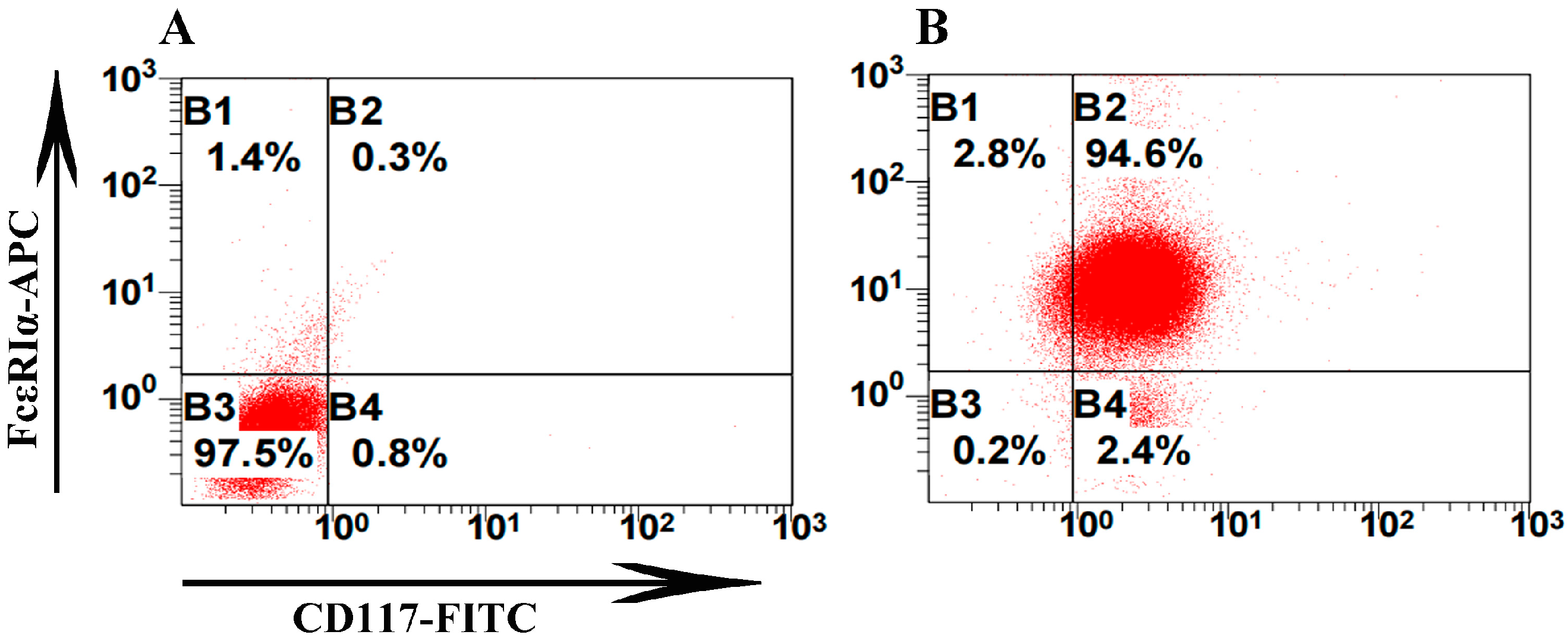

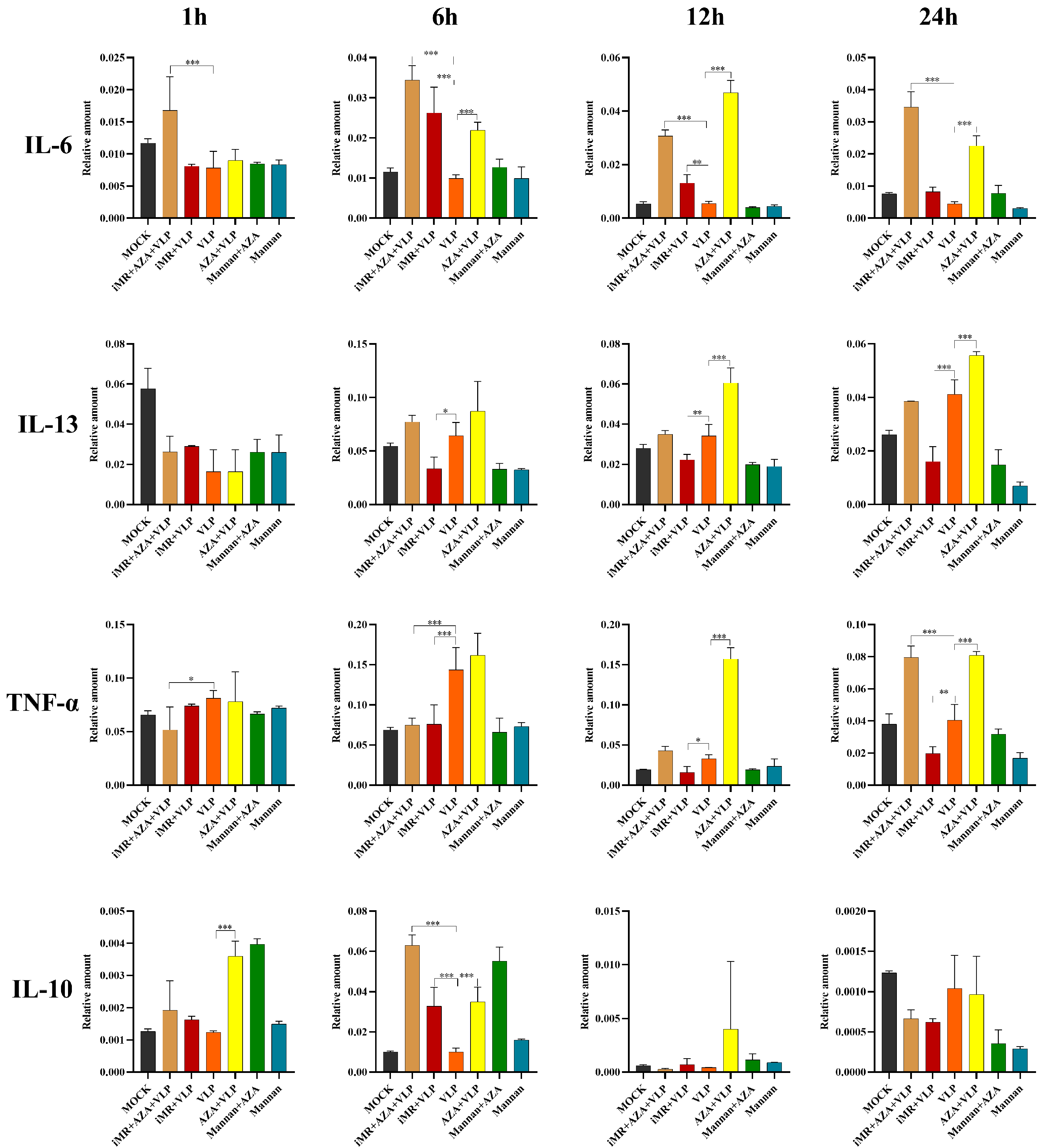
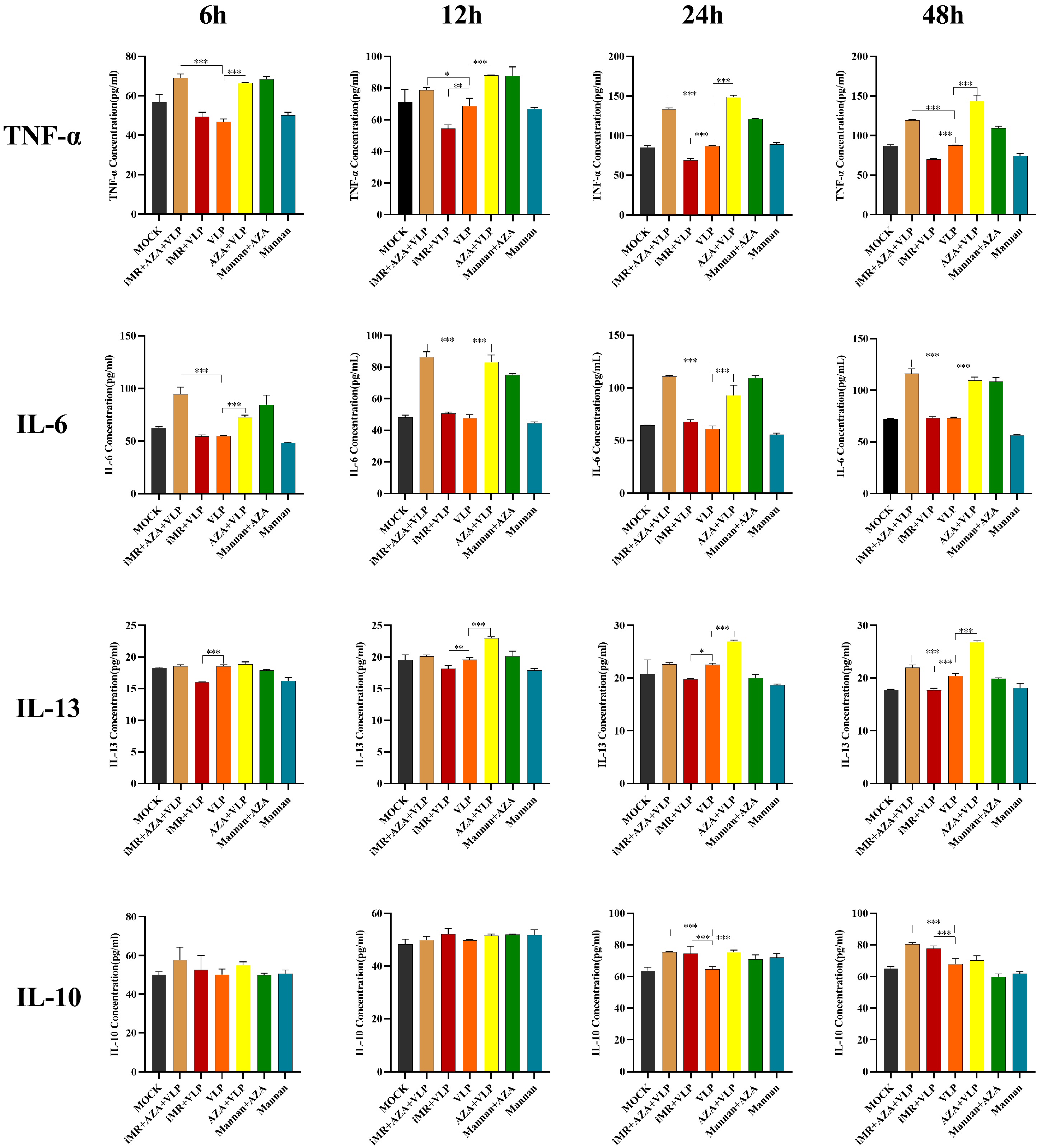
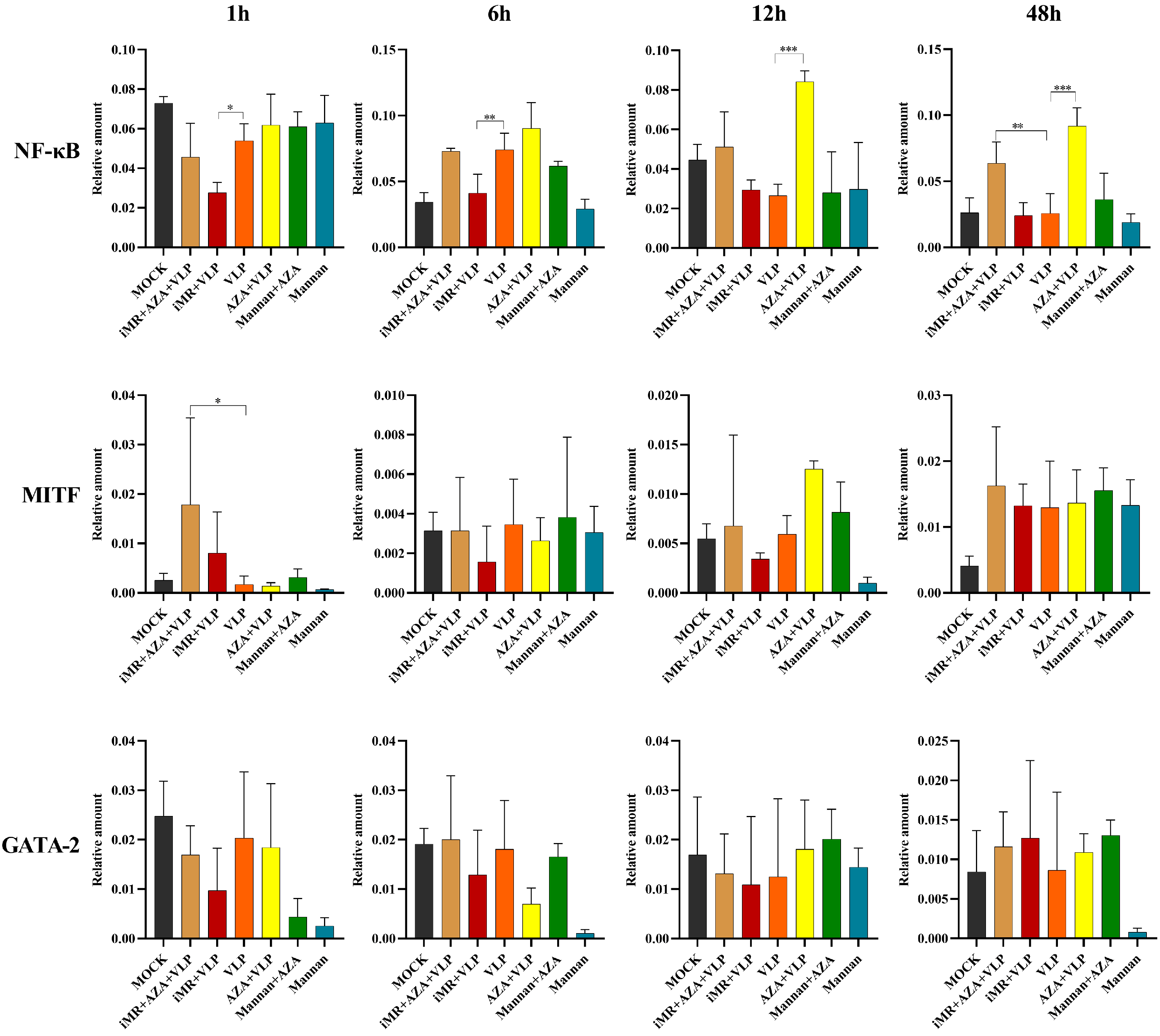

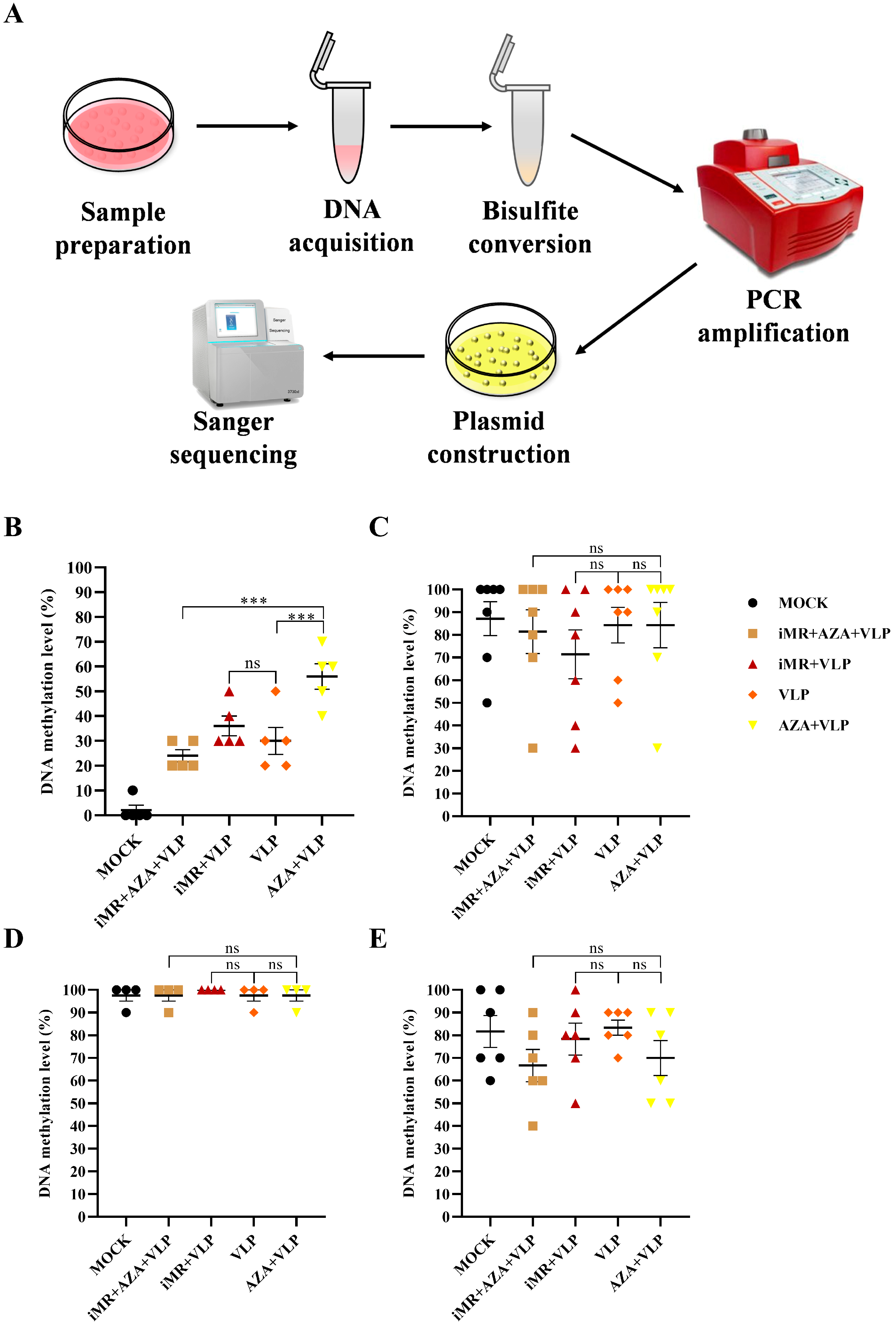
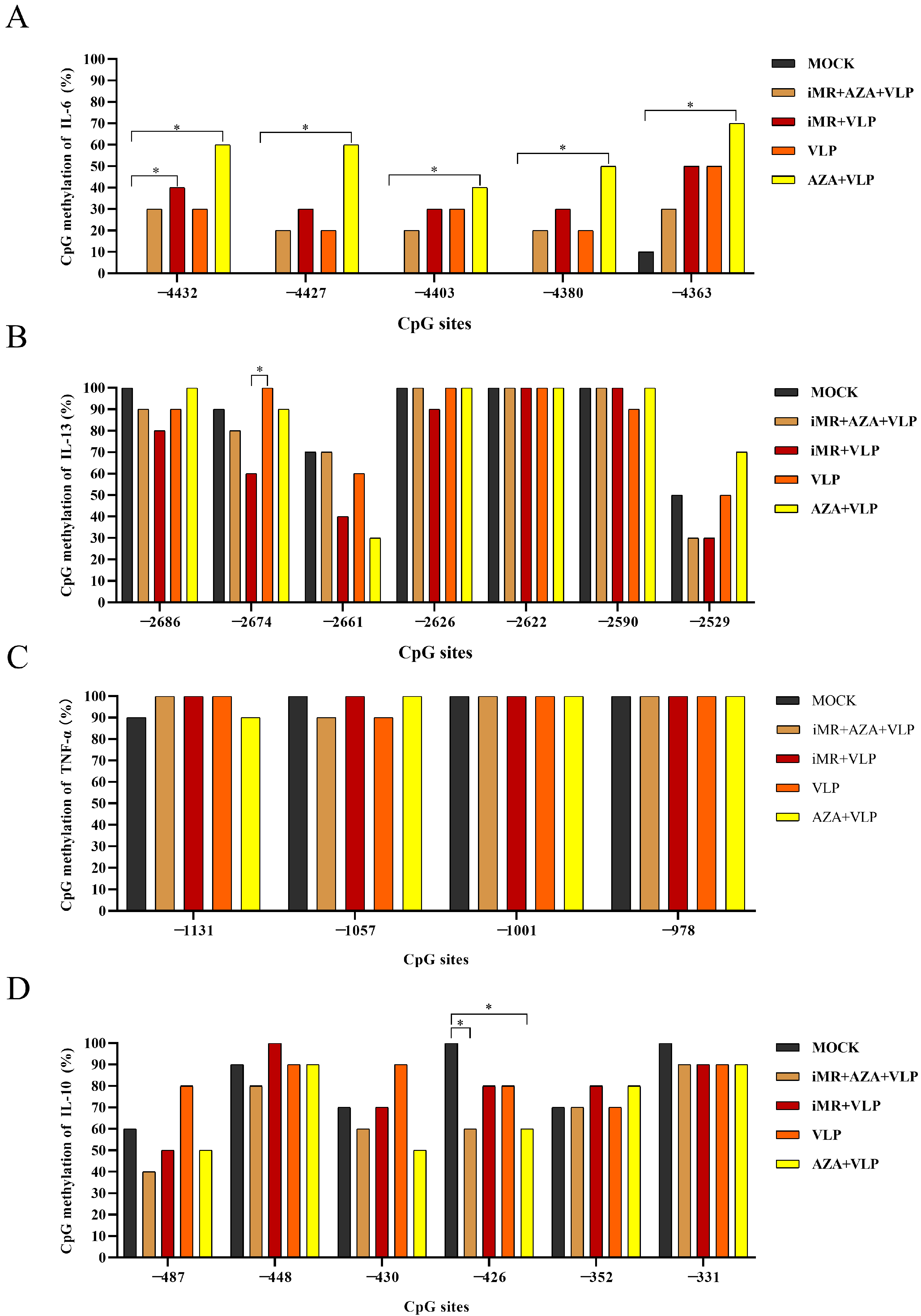
| Name | Sequence (5′–3′) | Tm (°C) | Product Size (bp) | Efficiency | R2 |
|---|---|---|---|---|---|
| GATA-2 | Forward: GGGTGGAACATACTCTTGGC | 51 | 120 | 1.92 | 1.00 |
| Reverse: GCACAGTAATGGCGGAACAA | |||||
| IL-6 | Forward: ACGGAATGGCTAAGGACCAAGAC | 53 | 132 | 1.97 | 1.00 |
| Reverse: GCGGAATGCCCACAAACTGATA | |||||
| IL-10 | Forward: CGCCCTATTTAGAAAGAAGCCCA | 52 | 140 | 1.99 | 1.00 |
| Reverse: AAAGGAAGAACCCCTCCCATCAT | |||||
| IL-13 | Forward: CAAGCAACCAGCCCTCA | 50 | 145 | 1.91 | 1.00 |
| Reverse: TACAACCTCCCCCCATTCA | |||||
| MITF | Forward: CATCACCTTTACCAACAACCTCG | 51 | 230 | 1.97 | 1.00 |
| Reverse: AACAGGCTCGCTAACACGCA | |||||
| TNF-α | Forward: AAAGGGAGAGTGGTCAGGTTGC | 51 | 95 | 2.01 | 1.00 |
| Reverse: CTCAGGGAAGAATCTGGAAAGGT | |||||
| NF-κB | Forward: CATCCTCGTCCGCCTATTAC Reverse: GACTCTCCTCCCTTTCCTTGT | 50 | 93 | 1.90 | 1.00 |
| GAPDH | Forward: CCTTCCGTGTTCCTAC | 45 | 152 | 1.73 | 1.00 |
| Reverse: GACAACCTGGTCCTCA |
| Name | Sequence (5′–3′) | Tm (°C) | Product Size (bp) |
|---|---|---|---|
| TNF-α | Forward: ATTTTGTTTGTTTGTGTTTGTTTTG | 48 | 206 |
| Reverse: CCCTAACTCATCCTTTAAATCTCCT | |||
| IL-13 | Forward: AGAGTTATTTTGTTGGGGTTTTTTT | 53 | 170 |
| Reverse: ATTCCTACCTACCCCTCTACTCACT | |||
| IL-6 | Forward: AATGGTGAAGTATAAGTAGTAGT | 46 | 344 |
| Reverse: ACCCTATAATTTCATCTCTTCTT | |||
| IL-10 | Forward: AGAAAGTTAGTTTAAGGGATTTTTT | 48 | 168 |
| Reverse: CAATCTCCCTACCTAAAAACCTACTAC | |||
| NF-κB | Forward1: GTTGTGGGTAGTTGTGGTTA | 49 | 356 |
| Reverse1: ACAACTTACCAAACTCATTTCTT | |||
| NF-κB | Forward2: TTTTTGTTTGATAGGGTGTGAAATA | 47 | 249 |
| Reverse2: ATCCTAAAAACAAATCAAAATCATC |
Disclaimer/Publisher’s Note: The statements, opinions and data contained in all publications are solely those of the individual author(s) and contributor(s) and not of MDPI and/or the editor(s). MDPI and/or the editor(s) disclaim responsibility for any injury to people or property resulting from any ideas, methods, instructions or products referred to in the content. |
© 2024 by the authors. Licensee MDPI, Basel, Switzerland. This article is an open access article distributed under the terms and conditions of the Creative Commons Attribution (CC BY) license (https://creativecommons.org/licenses/by/4.0/).
Share and Cite
Li, M.; Ning, P.; Bai, R.; Tian, Z.; Liu, S.; Li, L. DNA Methylation Negatively Regulates Gene Expression of Key Cytokines Secreted by BMMCs Recognizing FMDV-VLPs. Int. J. Mol. Sci. 2024, 25, 10849. https://doi.org/10.3390/ijms251910849
Li M, Ning P, Bai R, Tian Z, Liu S, Li L. DNA Methylation Negatively Regulates Gene Expression of Key Cytokines Secreted by BMMCs Recognizing FMDV-VLPs. International Journal of Molecular Sciences. 2024; 25(19):10849. https://doi.org/10.3390/ijms251910849
Chicago/Turabian StyleLi, Mingzhu, Peng Ning, Ruoman Bai, Zhanyun Tian, Shujia Liu, and Limin Li. 2024. "DNA Methylation Negatively Regulates Gene Expression of Key Cytokines Secreted by BMMCs Recognizing FMDV-VLPs" International Journal of Molecular Sciences 25, no. 19: 10849. https://doi.org/10.3390/ijms251910849
APA StyleLi, M., Ning, P., Bai, R., Tian, Z., Liu, S., & Li, L. (2024). DNA Methylation Negatively Regulates Gene Expression of Key Cytokines Secreted by BMMCs Recognizing FMDV-VLPs. International Journal of Molecular Sciences, 25(19), 10849. https://doi.org/10.3390/ijms251910849





